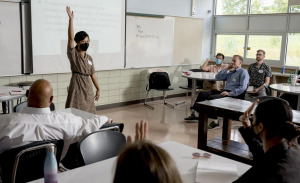
Indiana senators nix discussion on latest bill restricting classroom topics
The abrupt change in plans by the Senate Committee on Education and Career Development came after a Tuesday rally by groups opposed to such legislation.

The abrupt change in plans by the Senate Committee on Education and Career Development came after a Tuesday rally by groups opposed to such legislation.

Proponents characterize the strategy as funding students instead of systems, while opponents argue it leaves fewer resources for students in Indiana’s traditional public schools.

A bill in the Indiana Senate would significantly expand a state law that requires school districts to make their empty buildings available to charter schools.
The bill would allow students to meet graduation requirements through career experience and give students state-funded scholarship accounts to spend on workforce training outside their schools.

The vote puts Indiana on track to join several other states that have recently adopted financial literacy graduation requirements.

Gender identity and transitioning are the focus of a number of bills filed by Indiana lawmakers in the 2023 session, including one that would require teachers and schools to disclose if students request to change their names or pronouns.

A new bill in Indiana would establish accounts for students to pay for career training outside their schools, as part of House Republicans’ campaign to “reinvent” high school and align it more closely to the workforce.

Education advocates say they see expanding access to both early learning and higher education as critical to the state’s economic health.

Indiana’s English learner population has increased by 52% over the last five years.

The State Board of Education on Wednesday approved three locally created graduation tracks at two school districts and one adult learning center.
The Indiana Teacher of English Language Learners, or I-TELL, program will pay for tuition and fees for current educators to earn the additional licensure they need to become teachers of record for students who are learning English.

GOP leaders essentially stayed mum about whether they’ll take another crack at last year’s unsuccessful curriculum bill that sought to restrict what teachers could say about race and racism.
The Indiana Department of Education is supposed to seek input from businesses, industries, and postsecondary institutions about what characteristics students need to succeed in order to help inform the new standards.
Colearn Academy, a virtual school based in Arizona, applied earlier this year to open a school in Indiana, offering three learning pathways and the option for parents to purchase their own curriculum and activities with $600 yearly stipends.
The tutoring program, first created by House Enrolled Act 1251 in the spring and funded through federal relief dollars, is Indiana’s take on using tutoring to make up for the academic losses of the COVID-19 pandemic.

Indiana’s ubiquitous teacher licensing exam could be one reason behind the state’s shortage of teachers—especially Black and Hispanic teachers, according to a new report from Indiana University.
A similar model has already landed another Indiana virtual school in hot water with legislators, who passed a law earlier this year that expanded a previous ban on schools offering money as an incentive to enroll.
Half of Indiana’s high school juniors tested as college-ready in reading and writing on the SAT in 2022, but only around one-third met readiness benchmarks in math, according to Indiana Department of Education data released Wednesday.
Adjunct teacher permits represent the newest pathway to working in Indiana classrooms, following their approval by the state legislature earlier this year. Yet so far, school leaders don’t seem keen on using them.
As Indiana moves forward with an abortion ban, a small group of Democratic lawmakers and advocates has been hoping to expand the state’s sex education curriculum in an effort to reduce unplanned and unwanted pregnancies.